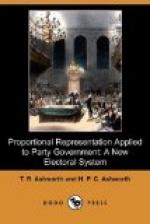CHAPTER V.
HOW THE EVILS OF THE PRESENT SYSTEM WILL BE REMEDIED.
From the inception of the representative system it has been usual to elect representatives in small districts, returning only one or two members, and the single-membered electorate is now almost universal. In the early Parliaments, however, elections were not contested as they are nowadays. It was merely a choice of the most suitable men to represent a corporate local community. Hence an indirect method of election was generally resorted to, the final choice being left to a small committee of the most important men. With the gradual rise of the party system the conditions entirely changed; and it is important to gain a clear idea of what is involved in the change.
In the first stage we have referred to it is not probable that there were any candidates at all. The position of member of Parliament was not sought after; it was rather thrust upon the man selected as a duty he owed the community. The choice would usually be unanimous, since there would be some men whose recognized influence and attainments would mark them off as most fitted for the position. If there was any difference of opinion it would be merely as to who was best fitted to represent all, and therefore there would never be any excluded minority.
The essential difference in the second stage is that every election is contested by two organized parties. The choice is now not of men only, but of measures and of men as well. It is a contest in the first place within each party as to who is best fitted to represent the party, and in the second place between the two parties for the support of the people. The party in a majority secures all the representation; the party in a minority none. Now, the minority is certainly not represented by the choice of the majority; on the contrary, its views are exactly the opposite. Hence the question arises: Is not this exclusion of the minority an injustice? Does it not amount to disfranchisement? The usual reply is either that the majority must rule or that the injustice done in some electorates is balanced in others, so that in the long run rough justice is obtained.
As to the first contention, it is the party which has the support of a majority of the whole people which should rule; and the excluded minority in some of the electorates belongs to this party. The second practically amounts to the statement that two wrongs make a right.
A practice prevails in the United States which will illustrate the position. Each State sends a number of representatives to Congress proportional to its population, and the division into electorates is left to the State. By manipulating the electoral boundaries the party which has a majority in each State is enabled to arrange that the injustice done to itself is a minimum, and that the injustice done to the opposing party is a maximum. By this iniquitous practice,




